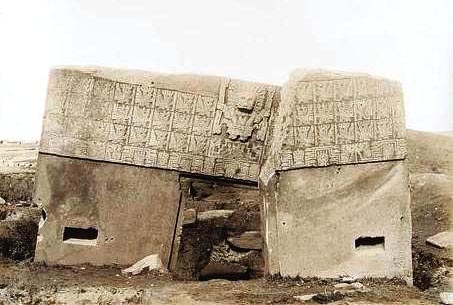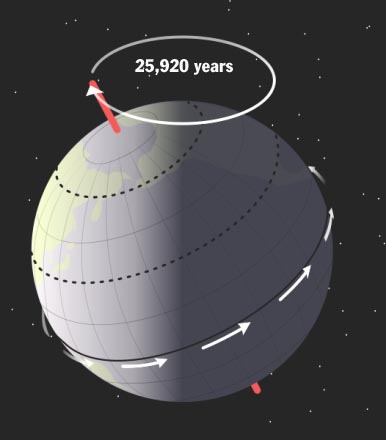CHANGE IS THE ONLY CONSTANT
How we react to the cycle of ages

Tiwanaku. The oldest temple on Earth charts the horizon stars in 15,000 BC.

Tiwanaku. The oldest temple on Earth charts the horizon stars in 15,000 BC.
Two years before the end of his life in 1961 the psychologist C.G. Jung made a remarkable statement in which he posits coming events which are in accord with the end of an era. As we know from ancient Egyptian history, they are the symptoms of psychic changes that always appear at the end of one Platonic month (2160 years) and at the beginning of another. They are, it seems, changes in the constellation of psychic dominants, of the archetypes, or 'gods' as they used to be called, which bring about, or accompany, long lasting transformations of the collective psyche. This transformation started within the historical tradition and left traces behind it, first in the transition from the age of Taurus to that of Aries, and then from Aries to the age of Pisces, whose beginning coincides with the rise in Christianity. We are now nearing that great change which may be expected when the spring-point enters Aquarius. 1
The world has indeed witnessed portents of major transformation since Jung's presentiment. All its systems of governance and ecology have reached precipitous levels not seen in historic times: unparalleled overpopulation, unsustainable growth, mass species extinction, bankruptcy of world governments, highest leverage of institutional debt relative to Gross Domestic Product, ad infinitum. And true to Jung's vision more than two million documents have been amassed on UFOs by the U.S. government alone; there has also been a rise in apparitions of holy figures, incandescent balls of light flying across the land at tremendous speed, the strange phenomenon of orbs captured by infrared flash photography, not to mention the sudden rise and worldwide proliferation of crop circles.
Indeed times are a-changing.
Unlike the linear thinking generally adopted in the West, many Eastern philosophies still honour the concept of a world governed by circular dynamics, as in the principles of Zen Buddhism. The idea of 'thinking in the round' dates back to the most remote of cultures such as the Jomon, the Aborigines and the Hopi. By observing nature and the universe they distilled everything that exists down to a few simple concepts, and central to these is that everything is governed by cycles.
These cycles do not have strict beginnings and endings as we in the modern, quantitative world expect, instead they ebb and flow over a liquid period of time that influences and ultimately alters our perception of pre-conceived parameters, much like an incoming tide slowly wipes away footprints by rearranging the particles of sand.
One technique the ancients used to measure cycles was stargazing. A close examination of the fundamental principles behind the vast majority of temples and stone circles shows a positive obsession with astronomy. From Tiwanaku in the Andes in 15,000 BC to the stone circle of Callanais in northern Scotland in 3000 BC, the motions of the planets and the stars were meticulously recorded so their corresponding effects could be mirrored on the face of the Earth. It was believed that everything that happens on the material plane is a reflection of actions taking place in the celestial sphere. Somehow they figured out that the universe is one giant, gnomonic and self-simulating holograph, not unlike the position now accepted in quantum physics.
And so our predecessors set about calculating the Earth's procession of the equinoxes ñ the wobble of the poles that traces an invisible cone in the sky as seen against the background of fixed constellations. From an earth-bound observer, each constellation is seen to move one degree every 72 years, the same constellation returning to its original position every 25,920 years, what is called a great Platonic year. Amazingly, there are precisely twelve constellations that circumambulate the equator, each more or less occupying 30 degrees of the sky or one house of the zodiac. Elementary maths shows that 30x12= 360 degrees, the circumference of a circle. Even more curious is that 30 x 72 years equals 2160 years, the period allotted to each Platonic month or age. And twelve constellations times 2160 years equals a full 25,920-year cycle.
It seems God is a mathematician.

Precessional Cycle: Earth behaves like a spinning top, its pole completing a full cycle in 25,920 years.
This fits very smoothly into the cycles influencing human affairs, as identified principally by the Egyptians. The Age of Taurus (c.4420 - 2260 BC) was governed by traits consistent with the astrological bull, where strength, stability, material forces, the earth, and great sensual beauty were the dictum of the day. This is evidenced in the wonderous temples and structures created during this period around the world, which is regarded as a time of unusual stability, the rise of agriculture and social husbandry notwithstanding.
As that age came to a close there was a marked decline of culture and the increase of blind impulse and aggression, certainly the qualities of the ram. The Age of Aries (c.2260 - 100 BC) was marked by institutional collapse, the rise in warfare, the absolution of established civilizations, and a general descent into barbarism across the Middle East as well as Europe. The responsibility of governorship was replaced by the control of despots. Temples also began a gradual move away from honouring the feminine, lunar principles of nature, and adopted solar, masculine values; the priesthood became centralized and corrupted and its consequences are still with us today.
Coincidentally, this also marked a period of significant meteorite strikes and catastrophic volcanic activity that certainly hastened this change in human attitudes. Around 3100 BC sea level rose rapidly by twelve feet, ice core samples and tree ring activity show signs of a large meteorite impact, and the Icelandic volcano Hekla went into convulsions that precipitated a mini ice age and led to the collapse of northern European cultures; in the Middle East, the fertile regions around Mesopotamia began a gradual decent into arid wasteland. Significant and catastrophic global climate change went hand-in-hand with a significant cooling of the planet. As the geologist Robert Schoch wrote, "There is evidence that currents in all the major oceans changed, probably in response to shifts in the atmosphere. The surface of the earth itself was moving around a great deal at this time. Every continent was affected by various patterns of uplift, subsidence, tilt, downwarping, earthquakes, and shifting riverbeds." 2
Continue to part II
Return to Articles

Temple of Callanais tracks the Moon, and is sited at its northernmost rising.